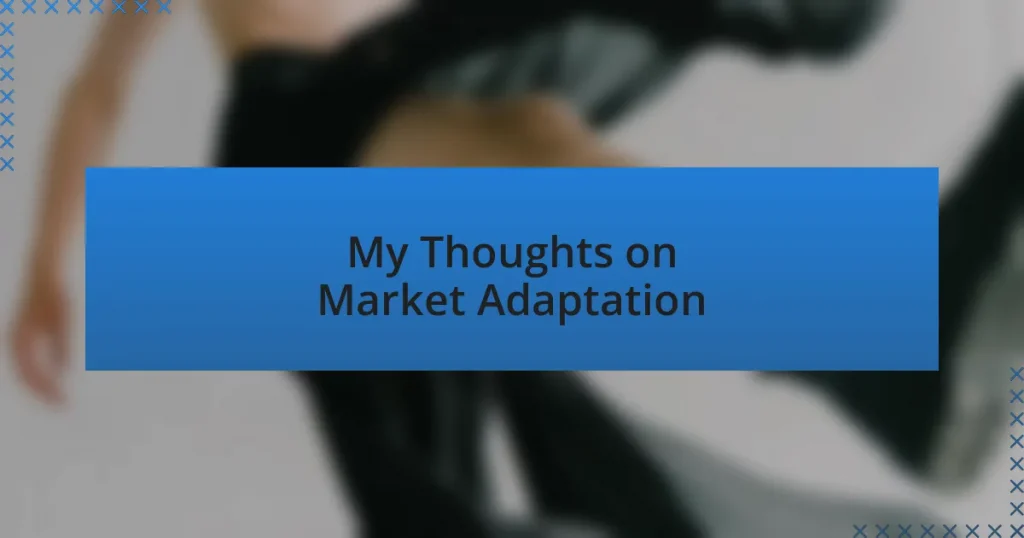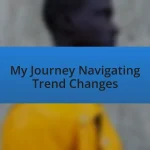Key takeaways:
- Market adaptation in fashion requires brands to respond swiftly to cultural shifts and consumer demands, especially emphasizing sustainability and inclusivity.
- Collaboration with local artists and the use of eco-friendly materials are effective strategies for brands to personalize offerings and connect with consumers.
- Future trends in fashion will be driven by technology, sustainability, and the celebration of diverse aesthetics, reshaping consumer experiences and brand identities.
Author: Charlotte Hawthorne
Bio: Charlotte Hawthorne is an acclaimed author known for her compelling storytelling and richly drawn characters. With a passion for exploring the complexities of human relationships, her novels often blend elements of romance, intrigue, and self-discovery. A graduate of the University of California, Charlotte has received multiple awards for her work, including the prestigious Silver Quill Award. When she’s not writing, she enjoys hiking in the Sierra Nevada mountains and sipping coffee at local cafes. Charlotte currently resides in San Francisco with her rescue dog, Jasper.
Understanding market adaptation in fashion
Market adaptation in fashion is not just a strategy; it’s a mindset. I remember when I first noticed a significant shift in consumer behavior toward sustainable fashion. It made me wonder, how many brands are truly ready to embrace this change? When a major player like Patagonia leads the way, it’s clear that the call for sustainability isn’t just a trend; it’s a demand that requires brands to evolve continuously.
In my experience, successful adaptation often hinges on closely observing cultural shifts and emerging trends. For instance, during the pandemic, I noticed how brands that pivoted to comfort-focused clothing not only survived but thrived. This adaptability wasn’t just a reaction; it was an understanding of what consumers craved in that moment of uncertainty. Have you thought about how quickly preferences can change based on external factors?
Lastly, market adaptation involves a delicate balance of innovation and tradition. I often find myself reflecting on how iconic brands maintain their heritage while introducing fresh ideas. It’s a fascinating journey, and it raises an important question: how do we honor the past while daring to craft the future? The answer lies in being receptive to feedback and willing to take calculated risks. Embracing this dynamic nature of fashion can lead to surprising breakthroughs.
Trends influencing market adaptation
Trends in consumer behavior significantly shape how the fashion industry adapts its market strategies. For example, I vividly recall walking through the streets and noticing an undeniable surge in athleisure wear. It wasn’t just about comfort; it became a cultural statement reflecting a society increasingly focused on wellness and versatility. How do brands respond to such a strong call for lifestyle integration? When they understand the importance of merging functionality with fashion, they position themselves for success.
Social media’s impact on trends cannot be overstated. I remember a time when viral fashion challenges rapidly increased sales for certain brands almost overnight. This phenomenon reveals how closely connected market adaptation is to digital platforms. Brands that harness the power of social media not only capture attention but also foster community, which is pivotal in a landscape where consumers seek genuine connections with their favorite labels. What would it take for companies to create this sense of belonging with their audience?
Moreover, inclusivity is transforming the fashion landscape profoundly. I felt a wave of relief when brands began featuring diverse body types and styles in their campaigns, reflecting a broader range of identities. It’s game-changing! The shift towards inclusivity challenges brands to rethink their designs and marketing strategies in a way that resonates with a more expansive audience. Can we still consider ourselves progressive if we exclude anyone from the formula? It’s becoming clear that true market adaptation lies in embracing diversity as a fundamental pillar of brand identity.
Strategies for adapting fashion styles
Developing a keen sense for current trends is crucial when adapting fashion styles. I remember a boutique near my home that thrived by altering its inventory based on seasonal shifts and local events. By being flexible and responsive to changes, they not only retained loyal customers but also attracted new ones. How often do you think brands evaluate their collections to stay in sync with their community’s preferences?
A unique strategy involves collaborating with local artists or influencers to create limited-edition pieces. I once attended a pop-up shop that featured a local designer whose work truly resonated with the community’s aesthetics. Watching customers engage with the designer in person was magical; it created a memorable experience that went beyond just purchasing a piece of clothing. Doesn’t it make you wonder how brands could further personalize their offerings through such partnerships?
Lastly, sustainability is an approach that can deeply resonate with consumers today. I recall my excitement when I discovered a fashion line that not only focused on trendy designs but also prioritized eco-friendly materials. It felt great to support a brand that aligned with my values. Isn’t it vital for fashion to prioritize the planet as much as it does style? This shift toward sustainable practices not only attracts environmentally conscious consumers but also encourages brands to innovate continuously.
Personal experiences with market adaptation
Often, I find that my personal journey in fashion has been a continuous exercise in adaptation. A few years back, I invested in several statement pieces that I believed would be timeless, only to realize that my local fashion scene quickly shifted towards minimalist styles. It was a moment of introspection for me: how could I embrace my individuality while also being mindful of the evolving market? This experience taught me the importance of blending personal style with an awareness of broader trends.
I vividly remember a time when I attended a fashion market event, where I stumbled upon a brand that was pivoting to incorporate streetwear elements into their line. The energy was electric; customers were thrilled, and it sparked a lively discussion about fashion’s role in self-expression. Experiencing firsthand how the brand’s willingness to adapt resonated with so many left me inspired. Isn’t it fascinating how certain shifts can transform a brand’s connection with its audience in such profound ways?
Then there was my encounter with a local designer who was experimenting with upcycled materials. I had never considered how adaption could stem from sustainability until I saw the beautiful creations born from discarded fabrics. As I admired each piece, I couldn’t help but reflect: how many stories could we tell through the clothes we wear if we all embraced this adaptive mindset? This realization heightened my appreciation for innovation within the industry and deepened my resolve to support those who prioritize both art and responsibility.
Tips for successful fashion adaptation
When it comes to successful fashion adaptation, one of the key tips is to stay curious and open-minded. I remember attending a workshop where the facilitator challenged us to experiment with unexpected color combinations. At first, I was hesitant, clinging to my usual palette, but once I embraced that challenge, I discovered how invigorating it can be to step outside my comfort zone. What if exploring the unknown could enhance not just your wardrobe but also your confidence?
Another critical strategy is to observe and analyze the changing trends around you. I like to take weekly strolls in my favorite shopping districts, simply observing what styles catch my attention. This practice has taught me to recognize subtle shifts in popular aesthetics, allowing me to adapt my style when necessary without losing my authentic flair. Isn’t it empowering to realize that you’re not just passively watching trends but actively participating in the fashion conversation?
Lastly, connecting with a community can greatly ease the process of adaptation. I once joined an online fashion group where members shared their personal adaptations to current trends. It was through these discussions that I realized the power of collaboration and collective insight. How amazing is it that you can find inspiration and support from others navigating similar style journeys? This sense of belonging makes adapting to fashion not just an individual endeavor, but a shared experience.
Future of fashion market adaptation
As we look to the future of fashion market adaptation, I can’t help but feel excited about how technology will play a pivotal role. Just think about the rise of virtual fitting rooms – I vividly recall using one while shopping online, and it felt like trying on clothes in a store without the hassle. This innovation not only saves time but also minimizes returns, making fashion shopping more efficient and enjoyable. Isn’t it fascinating how technology can transform our interaction with clothing?
Another trend I see shaping the future is the increasing emphasis on sustainability. I remember a moment, sitting in a panel discussion on eco-friendly fashion, where a designer talked about sourcing materials locally. It struck me how much we can shift the industry by simply choosing to support sustainable practices. By doing so, we’re not just changing our wardrobes; we’re making conscious choices that resonate with our values. How much more rewarding is it to wear something that’s not only stylish but also carefully crafted with the planet in mind?
Finally, the inclusion of diverse aesthetics is becoming more prominent. I once attended a fashion show that celebrated multicultural designs, which expanded my understanding of beauty in fashion. Witnessing garments that reflected different backgrounds encouraged me to embrace a richer and more varied wardrobe. It makes me wonder, how much more colorful and expressive could our future fashion landscape be if we continue to honor multiple perspectives? In this era of adaptation, the embrace of diversity could redefine what fashion means to us all.


